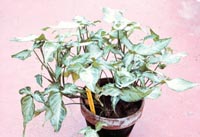Resource Library
Plant of the Week: 'Trileaf Wonder' (Arrowhead Philodendron, Nephthytis)
The University of Arkansas System Division of Agriculture does not promote, support or recommend plants featured in "Plant of the Week." Please consult your local Extension office for plants suitable for your region.
Plant of the Week
Arrowhead Philodendron, Nephthytis, 'Trileaf Wonder'
Latin: Syngonium podophyllum

This slow-growing tropical vine is native to tropical parts of Mexico and Central
America down to Panama. Like many members of the philodendron family, it produces
leaves that change as the plant gets older. In the juvenile stage, it has a single
united leaf blade that’s more or less arrowhead shaped and about 5 inches long.
As the plant matures and begins to climb up something -- in nature it would be a
tree trunk -- the leaf develops two or move basal lobes that separate into individual
leaflets that look like wings. The middle of the leaves are usually infused with shades
of white or gray.
This species appears to have been cultivated as a houseplant since the end of the
19th century. It’s been confused botanically with an African genus, Nephthytis, which it resembles. Even though the American species were reclassified in 1879 to
their own genus, the original name stuck as a common name.
Nephthytis is slow enough growing that it may take you a year or two to realize that
it’s spreading out and has some stems. I usually prefer to grow the plant as a table
top specimen in a 6-inch pot instead of as a vining plant. When the vines begin to
get too long and the plant gets too shaggy, I prune off the stems and use them to
start new plants.
One unusual characteristic of this group of plants is they have milky sap, which
is a rarity in this family.
Starting new plants is easy if single-eye cuttings are used. You can get a number
of cuttings by cutting a stem into pieces so each piece has a leaf and stem segment.
If a stem runner has 10 leaves, you would end up with eight single-eye cuttings and
one terminal cutting that contains two leaves.
All of these leaf segments would be jammed into a single 6-inch pot and kept watered
until the plants rooted and began growing. Covering the pot with a plastic bag will
make it easier to maintain uniform moisture until the already preformed roots grow
out.
In about two months, the leaf bud at the base of the petiole will begin growing.
With so many cuttings in the pot, you’ll be rewarded with a full pot in no time.
Commercially, nephthytis is propagated by tissue culture. The small pots you see
at home centers look like Lilliputian vestiges of a mature plant because they’re not
too distantly removed from the tissue culture cauldron where they were concocted.
Caring for nephthytis is easy. The plant is insensitive to cold temperatures, unlike
many members of the philodendron family. It can tolerate temperatures down to 35 degrees
without any chilling injury. Inside the home over winter, it will tolerate low light
surprisingly well; but like most plants, it prefers to be within sight of a window.
By: Gerald Klingaman, retired
Extension Horticulturist - Ornamentals
Extension News - September 29, 2000
The University of Arkansas System Division of Agriculture does not maintain lists of retail outlets where these plants can be purchased. Please check your local nursery or other retail outlets to ask about the availability of these plants for your growing area.